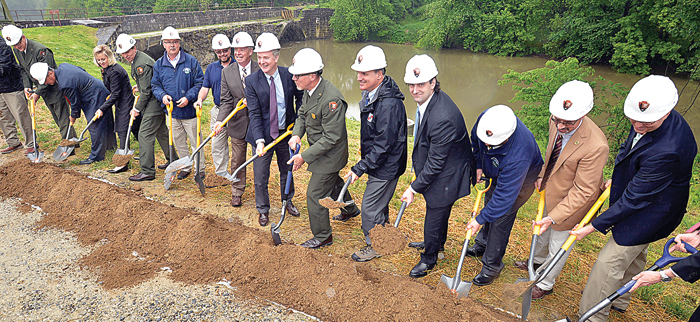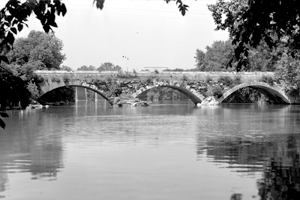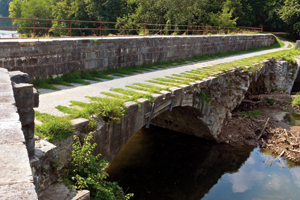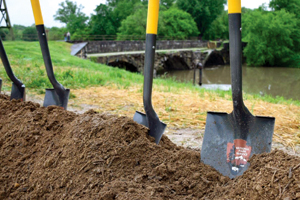Restoration of the Conococheague Aqueduct Took Tenacity: Williamsport groundbreaking

Federal, state and local dignitaries scoop and toss dirt to mark the beginning of the restoration; by Kevin G. Gilbert
Republished with permission from Herald-Mail Media.
Visitors at Williamsport’s Riverbottom Park might be doing a double-take once the National Park Service completes its next multimillion-dollar attraction next to the Cushwa Basin.
They will glance up at Conococheague Creek, then…
Wait a minute?
Is that a boat mysteriously floating above the creek?

1959; National Park Service
It might appear that way, but actually the boat will be gliding through another body of water hanging over the Conococheague.
It’s known as an aqueduct, and Kevin Brandt said it is oftentimes difficult to explain the concept to park visitors because there are very few of them in existence.
Aqueducts are essentially water-filled bridges, and the Conococheague Aqueduct next to the Cushwa Basin was an integral part of C&O Canal operations in Williamsport during the 1800s and early 1900s.
It’s been a long time since there was water within the stone structure, but the National Park Service is getting ready to embark on an $8 million effort to re-water it, opening a whole new experience for boat riders on the canal in Williamsport.
“Aqueducts like this are truly unique and attract a lot of people,” said Brandt, superintendent of the Chesapeake & Ohio Canal National Historical Park.
Rebuilding the aqueduct has been the stuff of dreams for years for people like former Williamsport Mayor James G. McCleaf II.
When he was elected in 2005, McCleaf questioned how the town could grow.
“But we had the C&O Canal in our backyard,” McCleaf said in a recent interview.
The park, which stretches 184.5 miles from Washington, D.C., to Cumberland, Md., attracts about 5 million visitors a year. Between 2005 and 2016, the number of visitors to the Williamsport section increased from 159,444 to 433,484 annually as the park has added new attractions there, said McCleaf, who decided not to seek re-election this year.

2013; National Park Service
But when he was elected, McCleaf said, he did not believe the town was doing enough to capitalize on the local attraction.
Donald F. Munson, who was then a state senator, agreed.
Munson, now a Hagerstown City Councilman, was able to help secure bond bill funding through the Maryland General Assembly, which helped with making an old railroad lift bridge along the canal at Williamsport operational again and restoring Lock 44 near Williamsport, McCleaf said.
McCleaf wanted to eventually see the Conococheague Aqueduct restored, and it received some funding early on.
But the money had to be diverted to repair the canal in the Big Slackwater area, McCleaf said.
“It kind of sat dormant a while to find the money,” McCleaf said.
Then McCleaf was told that Maryland House Appropriations Committee Chairwoman Maggie McIntosh, D-Baltimore City, was going to be making a visit to the Washington County Free Library one day.
McIntosh is an advocate of the canal and loves to ride bikes.

2017; National Park Service
McIntosh told McCleaf about a Maryland Transportation Alternatives Program Grant as a possible funding source for the aqueduct restoration.
It worked, with $6.24 million coming from the grant program to refurbish the aqueduct.
“Then we got a little sugar on top,” McCleaf said.
To help commemorate the 100th anniversary of the National Park Service last year, a National Park Service Centennial Challenge Fund was set up to fund projects. It was a matching grant program, meaning any funded projects would have to get money from another source as well, said Brandt.
Because the aqueduct project also received a $722,904 Maryland Bikeways Grant, that funding was used as part of a match to receive a $1.33 million National Park Service Centennial Challenge Fund, according to Brandt and McCleaf. There were other nonfederal sources of money that were used for the grant, Brandt said.
With a groundbreaking of the Conococheague Aqueduct restoration set for May 5 and an invitation list that includes Gov. Larry Hogan and other dignitaries, McCleaf is happy, to say the least.
| Williamsport marks start of $8.3M C&O Canal Project
The long-awaited restoration of the Conococheague Aqueduct on the Chesapeake and Ohio Canal officially got under way on May 5, as leaders from every level of government gathered with National Park Service officials and residents to celebrate. Even the skies took a break for most of the groundbreaking ceremony from the steady rain that started the previous night. When finished, the aqueduct will be returned to its 1920s appearance and become the first watered, operational aqueduct on the canal since 1924. |
“I tell you what, on May 5, you won’t see a happier man than me,” McCleaf said. Sen. Andrew Serafini, R-Washington, credited McCleaf and Town Clerk/Treasurer Donnie Stotelmyer with being “tenacious” in their pursuit for project funding. “They have never taken no for an answer. Not even a maybe,” Serafini said. Stotelmyer said McCleaf sent him everywhere, from crab feeds to Capitol Hill, to lobby for the project.
Stotelmyer said talk of re-watering the aqueduct has been going on in town for 50 years.
“A lot of people in Williamsport still don’t believe it (is about to happen),” Stotelmyer said.
State Sen. George Edwards, R-Washington/Allegany/Garrett, said projects that get state and federal funding happen every so often. But the Conococheague Aqueduct renovation is unique because of the millions of dollars in funding, Edwards said.
Brandt said the aqueduct revitalization will involve construction of a wooden wall, a simulation of a wood wall that was installed on the aqueduct after a wall collapse in 1920 that resulted in Capt. Frank Myers’ canal boat tumbling into Conococheague Creek.
Among the attractions that the C&O Canal has added in recent years are launch boats, which enable visitors to ride from the Cushwa Basin to Lock 44. Once the aqueduct is refurbished, Brandt estimated, about another 1,000 feet of watered canal will be added for visitors to ride on.
The funding for the project will pay for other projects at the canal, including a new crossing for tourists at the Williamsport Visitor Center. Because the project will result in a longer watered section of the canal, there will have to be a new crossing over it, said Brandt.
Other work will include restoration of a historic coal yard. Additional funding will be sought to create a “new interpretive landscape” around the Cushwa basin, the National Park Service said.
Article by Dave McMillion and Tamela Baker—Herald-Mail Media reporters.
Appears in Vol. 20, No. 3 of the Maryland Natural Resource magazine, summer 2017.


 1-888-373-7888
1-888-373-7888 233733
233733